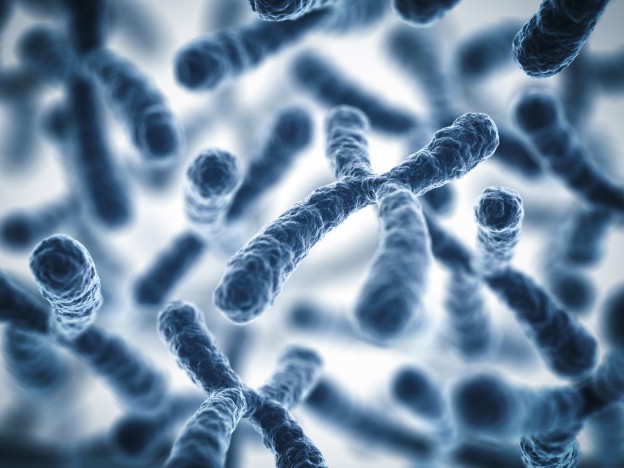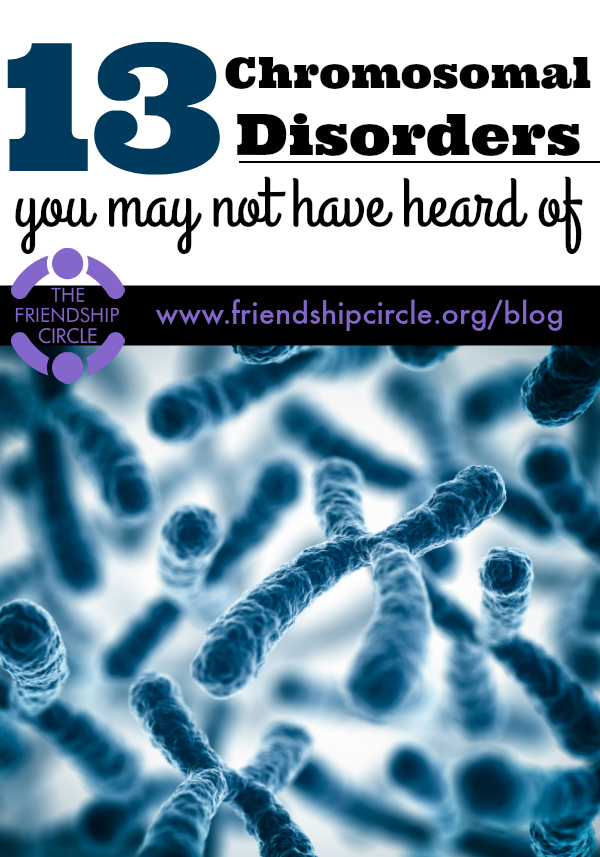
Resources 
13 chromosomal disorders you may not have heard of
You've heard of Downs syndrome and Fragile X syndrome, but what about Jacobsen syndrome? Or 22q11.2 deletion syndrome? In this post we bring attention to some lesser known chromosomal disorders. If your child has one of these conditions please share your experiences with us in the comments below.1. Wolf-Hirschhorn syndrome
Description: Wolf-Hirschhorn syndrome is caused by the deletion of the distal short arm of chromosome 4. The disorder’s major features include a characteristic facial appearance, delayed growth and development, intellectual disability, and seizures. Organizations promoting awareness: The Real Story About Wolf-Hirschhorn Syndrome In the news: Living With Wolf-Hirschhorn Syndrome2. Jacobsen Syndrome
Description: Jacobsen syndrome, also known as 11q deletion disorder, results from a loss of genetic material from the end of the long arm of chromosome 11. Signs and symptoms of this condition vary, but most individuals experience delayed development in motor skills and speech, cognitive impairments, learning difficulties, and some behavioral problems. Organizations promoting awareness: 11q Research & Resource Group In the news: Thousands raised for Jacobsen Syndrome3. Angelman syndrome
Description: Angelman syndrome (AS) is an example of genomic imprinting, where the deletion or inactivitation of genes on the maternally inherited chromosome 15 causes the paternal copy, which may be of normal sequence, to be imprinted and silenced. AS is characterized by intellectual and developmental delays, sleep disturbances, seizures, and jerky movements, but also frequent laughter or smiling and usually have a happy demeanor. Organizations promoting awareness: F.A.S.T & Angelman Foundation, Inc. In the news: In Depth: Angelman Syndrome4. Turner syndrome
Description: Turner syndrome (TS) occurs when one of the two X chromosomes in females is either missing or incomplete. The most common symptoms are short stature and gonadal dysgenesis, which can cause incomplete sexual development and ovarian failure and infertility. As of right now, there is no known cause of TS. Organizations promoting awareness: Turner Syndrome Society of the US In the news: Family spreads awareness of Turner syndrome5. 22q11.2 deletion syndrome
Description: 22q11.2 deletion syndrome is caused by the deletion of a small piece of chromosome 22 near the middle of the chromosome. Because signs and symptoms of 22q11.2 deletion syndrome are varied, different groupings of symptoms were once described as completely separate conditions, named DiGeorge syndrome, velocardiofacial syndrome, and conotruncal anomaly face syndrome. Organizations promoting awareness: The International 22q11.2 Deletion Syndrome Foundation, Inc. In the news: 22q11.2 deletion syndrome conference to bring together researchers, educators, families6. Triple X Syndrome
Description: Triple X Syndrome is characterized by an extra X chromosome in each of a female’s cells. It does not cause any unusual physical features but is associated with the increased risk of learning disabilities and delayed development of speech and language skills. Organizations promoting awareness: Triple X Syndrome In the news: What Is Triple X Syndrome? What Causes Triple X Syndrome?7. Williams Syndrome
Description: Williams syndrome is caused by a deletion of genetic material from portions of the long arm of chromosome 7, a region that consists of more than 25 genes. Researchers have identified a few of the specific genes related to Williams syndrome, but the relationship between most of the genes in the deleted region and the symptoms of Williams syndrome is still unknown. Organizations promoting awareness: Williams Syndrome Association In the news: Williams syndrome shows gene-behavior links: Key to autism?8. Cri du Chat Syndrome
Description: Cri du Chat syndrome results from missing a piece of chromosome 5. Symptoms include a high-pitched cry that sounds like a cat, downward slant of the eyes, partial webbing or fusing of fingers or toes, and slow or incomplete development of motor skills. Organizations promoting awareness: Five P Minus Society In the news: ‘Cat Cry’ Syndrome Often Undiagnosed9. Trisomy 13/Patau syndrome
Description: Trisomy 13, also called Patau syndrome, is a disorder in which an individual has three copies of genetic material from chromosome 13, rather than two. It can occur in three forms: Trisomy 13, which has a third chromosome 13 in all cells; Trisomy 13 mosaicism, which has a third chromosome 13 in some cells; and partial Trisomy, which has the presence of part of an extra chromosome 13 in the cells. Organizations promoting awareness: Living With Trisomy 13 In the news: Sequenom Validates MaterniT21 for Trisomy 18 and 13 Detection10. Trisomy 18/Edwards syndrome
Description: Trisomy 18, or Edwards syndrome, occurs when a person has a third copy of material from chromosome 18 instead of the usual two copies. Some symptoms include clenched hands, feet with a rounded bottom, mental deficiency, underdeveloped fingernails, and an unusual shaped chest. Organizations promoting awareness: Trisomy 18 Foundation In the news: Baby Jalyssa’s Story: Fighting The Odds, Living With Edward’s Syndrome11. Cat eye syndrome
Description: For individuals with cat eye syndrome, the short arm (known as 22p) and a small region of the long arm (22q) of chromosome 22 are present three or four times, rather than twice. Characteristic features of the disorder include mild growth delays before birth, mild mental deficiency, and malformations of the skill and facial region, the heart, the kidneys, and/or the anal region. Organizations promoting awareness: Support for Disorders of Chromosome 22 In the news: Blog: “Our Journey with Cat Eye Syndrome”12. Trisomy 16
Description: Full Trisomy 16 occurs when an individual has three copies of chromosome 16 instead of the usual two and is the most common chromosomal cause of miscarriage during the pregnancy’s first trimester. Mosaic Trisomy 16 is a rare disorder in which an extra chromosome 16 is present in some cells, but not all. Some common symptoms include intrauterine growth retardation (IUGR) and congenital heart defects. Organizations promoting awareness: Disorders of Chromosome 16 In the news: Trisomy 16: the Leading Cause of Miscarriage13. Charcot-Marie-Tooth disease
Description: Charcot-Marie-Tooth (CMT) disease is the most common inherited neurological disorder and is caused by genetic mutations. CMT1A results from a duplication of the gene on chromosome 17 that carries instructions for producing the peripheral myelin protenin-22. Organizations promoting awareness: Charcot-Marie-Tooth Association In the news: Disease Cause Is Pinpointed With Genome Like this post? Pin it for later on Pinterest here:



